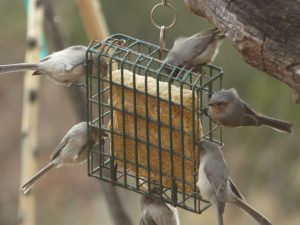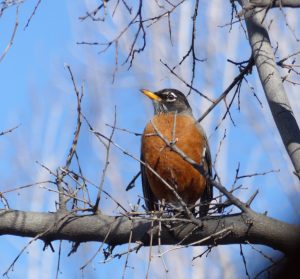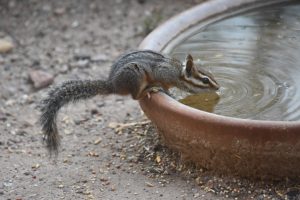We would like to thank Ed and Betty of Columbia, Missouri. They were guests here at Casitas de Gila Guesthouses in November 2019. They had such a wonderful time birding here, that they left this amazing story in our Casita guestbook. It’s so wonderful, we just have to share it!
——————————————————————————–
Our deep thanks to Becky & Michael for their long labor of love shepherding this place. We benefited immensely.
We arrived when a bitter arctic air mass (in Nov!) swept through the eastern states. Our town, Columbia, MO, had a record low of 9°F / snow. It was a chilly morning here. I put a “bird bath” out on the outside table and it froze solid 2 mornings. Interestingly, there wasn’t much frost on the car, though; too dry I suppose. So the mornings and evenings were just right for a comfortable cedar wood fire inside. But the afternoon temps climbed to the 60s each day! And the skies were wonderfully clear and blue. Absolutely still in the mornings, with the (modest) breeze gathering in the afternoon.
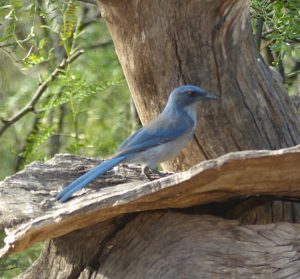
I brought 10 lbs of birdseed (to add to the Casitas’ store) and enjoyed the morning and evening parade. A few were familiar from back home: the cardinal, white-crowned sparrow, and junco (although the Oregon color phase was present here). The bluejay of Missouri was replaced here by the SCRUB JAY, just as beautiful in its own way. At first I thought it was timid … turns out these jays get real used to you! Our secretive brown thrasher was replaced here by the (also secretive) CURVE-BILLED THRASHER. Indeed, that impressive beak is curved like a scimitar. And that reality is not lost on the other birds … this thrasher ruled the feeding dish. Even the scrub jay, slightly larger, moves right out of the way when the yellow eyes show up, scurrying out from under the juniper.
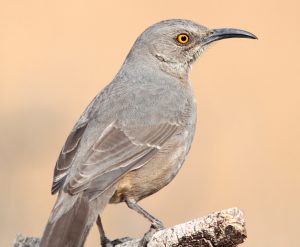
Another cousin-bird here was the juniper titmouse, standing in for our more familiar tufted titmouse. It’s smaller and “gray-browner” but very much a titmouse in its behavior.
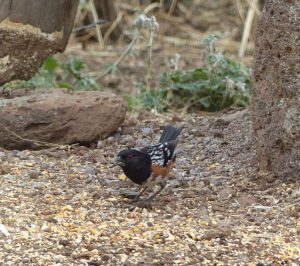
The handsome SPOTTED TOWHEE splashed in a couple of times. Beautiful, quick, wary bird – much like the mourning dove back East.
Finally, at least as well as last, was the BUSHTIT. There’s really no parallel to those tiny birds back home. Diminutive! Just ½ as big as a Carolina chickadee. They buzzed in like 6-8 bees, then away.
These wonderful birds graced our feeding station. But there were birds we saw that were part of the larger landscape. And the one who lives on the largest scale is the raven. The (common) raven owns this country. They see everything for miles from their high mt. Lairs, or from the sky, which they can “row across” in a hurry. Their amazing voice announces them, high overhead, sailing up Bear Creek, or echoing from the surrounding peaks.
On a lesser scale, but still leading a landscape-wide life, were the ROBINS. From afar they zoom in, dropping into the tall trees lining Bear Creek, perhaps after hackberry fruit, perhaps ready for a drink and a splash. I suspect they help themselves to the juicy fruit of the one-seed juniper, of which there must be about a trillion in this state. Yes, juicy! The Eastern red cedar we encounter in Missouri makes a lot of fruit (not technically berries, but botanically a modified cone), but their (smaller) fruit is mealy and dry. I didn’t see robins eating the strangely juice cones, but I suspect it. And I did see their cousins the western bluebirds eating them.
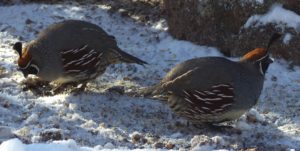
We walked up the drive (“Courage”) and up the Double E Ranch Road and saw about 40 of these wonderful bluebirds, clustered in just one juniper …one tree. Out of a trillion … gorging themselves on juicy fruit. Then on the way back, the GAMBELS QUAIL were there. Some tree. They panicked out of there, running across the road in front of us. So why that one tree? I looked it over. Loaded with fruit, but so are all the other female junipers — for miles around. A mystery. But it was a very orderly panic. These collegial birds run in single file, always. And there are other single-file creatures on that road. A group of 9 winter-gray mule deer bounded across as well. Single file, and “pronking” to demonstrate just how foolish we would be to chase them. Actually, we’re not that foolish, but it was fun to see them pronk.
The red-tailed hawk we saw sitting solemnly on a telephone pole was just the opposite of the exuberant deer. He didn’t even twitch as we went by, positive that the pole was erected for him and him alone. But the bird seemed quite large — probably a female.
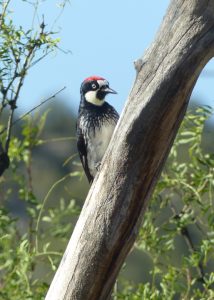
A couple of other landscape-wide birds were woodpeckers. The northern flicker flies from place to place out here. The big white blotch above the tail really shows in a land of gray trees. But where was the mustache? I’m color-blind, so couldn’t see the red malar on these western birds. And another special sighting was the ACORN WOODPECKER. They’ve a black and white cousin back east as well, the red-headed woodpecker. A fast flyer, this acorn-eating hoarder flashed across the sky ahead of us like a comet!
Then there were some particular birds. That is, because they’re particular about where they live; only in certain habitats. The hairy woodpecker we saw down on the large cottonwoods lining Bear Creek. The mallards we saw having a float down the Gila River. And the CRANES! We saw them from the bridge in the tall grass by the Gila River. It was a group of four. Earlier in the day I heard their wild raucous trumpeting fro the top of the Hooker Loop. That’s ~3 miles away. Their calls carried perfectly in the still morning air.

Finally, my last bird. This one I saw down in the creek bottom. I heard a loud scolding, then to my surprise there were two “furious” little wrens. Very bright little birds, marvelous marsh wrens. I had never seen one before. It was a real gift. They were frequenting the seep willow thicket, a perfect place for a marsh-loving bird.
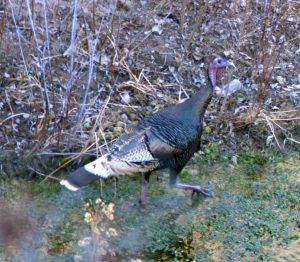
Of course there were other evidences of birds and animals. I hiked up the Double E Ranch trail [what we call the Casitas’ Paradise Overlook trail] to the top of a little mountain. Wild turkeys had preceded me, their droppings in abundance proving it. And I should mention the cliff chipmunks. They frequent the bird feeding station as much as any of the birds, waving their plumy tails if a bird approaches too close. They like to scatter the juncos and even stand their ground (in the feed dish) against the scrub jays! However, they yield to the yellow-eyes.
So there’s lots more, but I’ve burned up too many pages and I’m done. Thank you again, Becky and Michael. We hope to see you again.

